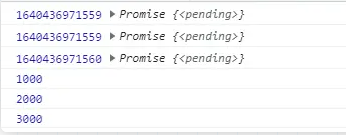ECMAScript-9(ES2018)
提案
新特性
Async iterators异步迭代器Object rest properties剩余属性Object spread properties扩展属性Promise.prototype.finally
对象的方法扩展
rest 剩余参数与 spread 扩展运算符在 ES6 中已经引入,不过 ES6 中只针对于数组, 在 ES9 中为对象提供了像数组一样的 rest 参数和扩展运算符
rest 剩余参数:...user
// rest剩余参数...user
function connect({ host, port, ...user }) {
console.log(host);
console.log(port);
console.log(user);
}
connect({
host: "127.0.0.1",
port: 3306,
username: "root",
password: "root",
type: "master",
});Object rest properties
举例:
let test = {
a: 1,
b: 2,
c: 3,
d: 4,
};
let { a, b, ...rest } = test;
console.log(a); // 1
console.log(b); // 2
console.log(rest); // {c: 3, d: 4}⚠️ 注意:
null不能使用扩展运算符
let { a, b, ...rest } = null; // ❌spread 扩展运算符
const skillOne = {
q: "天音波",
};
const skillTwo = {
q: "金钟罩",
};
const skillThree = {
q: "天雷破",
};
const skillFour = {
q: "猛龙摆尾",
};
const mangseng = {
...skillOne,
...skillTwo,
...skillThree,
...skillFour,
};
// 合并的对象打印
console.log(mangseng);举例:
let test = {
a: 1,
b: 2,
};
let result = { c: 3, ...test };
console.log(result); // {c: 3, a: 1, b: 2}
let test = null;
let result = { c: 3, ...test }; // {c: 3}注意点
const obj = { x: { y: 10 } };
const copy1 = { ...obj };
const copy2 = { ...obj };
obj.x.y = "jimmy";
console.log(copy1, copy2); // x: {y: "jimmy"} x: {y: "jimmy"}
console.log(copy1.x === copy2.x); // → true如果属性的值是一个对象的话,该对象的引用会被拷贝,而不是生成一个新的对象。
我们再来看下 Object rest 的示例:
const input = {
a: 1,
b: 2,
c: 3,
};
let { a, ...rest } = input;
console.log(a, rest); // 1 {b: 2, c: 3}当对象 key-value 不确定的时候,把必选的 key 赋值给变量,用一个变量收敛其他可选的 key 数据,这在之前是做不到的。注意,rest 属性必须始终出现在对象的末尾,否则将抛出错误。
正则表达式扩展
命名捕获组
ES9 允许命名捕获组使用符号『?<name>』,这样获取捕获结果可读性和可维护性更强
原来提取 url 例子
let str = "哈哈哈";
// 提取 url 与 [标签文本]
const reg = /(.*)<\/a>/;
// 执行
const result = reg.exec(str);
// 打印输出
console.log(result[1]);
console.log(result[2]);命名捕获组代码例子
let str = "哈哈哈";
// 提取 url 与 [标签文本]
const reg = /.*)">(?<text>.*)<\/a>/;
// 执行
const result = reg.exec(str);
// 打印输出
console.log(result.groups.url);
console.log(result.groups.text);分组名字:?<url>
反向断言
ES9 支持反向断言,通过对匹配结果前面的内容进行判断,对匹配进行筛选。
正向断言代码例子 (以前的语法)
//声明字符串
let str = "JS5211314 你知道么 555 啦啦啦";
//正向断言
const reg = /\d+(?=啦)/;
const result = reg.exec(str);反向断言代码例子
//声明字符串
let str = "JS5211314 你知道么 555 啦啦啦";
//反向断言
const reg = /(?<=么)\d+/;
const result = reg.exec(str);
console.log(result);dotAll 模式
正则表达式中点.匹配除回车外的任何单字符,标记『s』改变这种行为,允许行终止符出现
代码例子
let str = `
肖生克的救赎
上映日期: 1994-09-10
阿甘正传
上映日期: 1994-07-06
`;
// 声明正则
// 旧的正则:缺点,匹配多个这种形式的内容结构会很麻烦
// const reg = /\s+(.*?)<\/a>\s+(.*?)<\/p>/;
// dotAll 模式:.* g:全局匹配
const reg = /.*?(.*?)<\/a>.*?(.*?)<\/p>/gs;
//执行匹配
const result = reg.exec(str);
let result;
let data = [];
while ((result = reg.exec(str))) {
data.push({ title: result[1], time: result[2] });
}
//输出结果
console.log(data);爬虫爬取的时候把元素里内容的提取
String 扩展
放松对标签模板里字符串转义的限制, 遇到不合法的字符串转义会返回 undefined,并且从 raw 上可获取原字符串。
下面是一个 es6 的标签模板 如果对这个语法感到陌生,请参考:字符串的扩展 - ECMAScript 6 入门 (ruanyifeng.com)
const foo = (a, b, c) => {
console.log(a);
console.log(b);
console.log(c);
};
const name = "jimmy";
const age = 18;
foo`这是${name},他的年龄是${age}岁`;参数打印如下:

ES9 开始,模板字符串允许嵌套支持常见转义序列,移除对 ECMAScript 在带标签的模版字符串中转义序列的语法限制。
function foo(a, b, c) {
console.log(a, b, c);
}
// 在标签函数中使用
// unicode字符\u{61} 对应的值为 a
// unicode字符\u{62} 对应的值为 b
// \unicode 是一个无效的unicode字符
foo`\u{61} and \u{62}`;
foo`\u{61} and \unicode`;
注意点
在模板字符串中,如果输入无效的 unicode 字符,还是会报错。只有在便签模板中 从 es9 开始才不会报错。
let string = `\u{61} and \unicode`;
console.log(string); // Uncaught SyntaxError: Invalid Unicode escape sequence异步迭代 for await of
异步迭代器(for-await-of):循环等待每个 Promise 对象变为 resolved 状态才进入下一步。
我们知道 for...of 是同步运行的,看如下代码
function TimeOut(time) {
return new Promise(function (resolve, reject) {
setTimeout(function () {
resolve(time);
}, time);
});
}
async function test() {
let arr = [TimeOut(2000), TimeOut(1000), TimeOut(3000)];
for (let item of arr) {
console.log(Date.now(), item.then(console.log));
}
}
test();上面打印结果如下图

上述代码证实了 for of 方法不能遍历异步迭代器,得到的结果并不是我们所期待的,于是 for await of 就粉墨登场啦!
ES9 中可以用 for...await...of 的语法来操作
function TimeOut(time) {
return new Promise(function (resolve, reject) {
setTimeout(function () {
resolve(time);
}, time);
});
}
async function test() {
let arr = [TimeOut(2000), TimeOut(1000), TimeOut(3000)];
for await (let item of arr) {
console.log(Date.now(), item);
}
}
test();
// 1560092345730 2000
// 1560092345730 1000
// 1560092346336 3000for await of 环等待每个 Promise 对象变为 resolved 状态才进入下一步。所有打印的结果为 2000,1000,3000。
Async iterators 异步迭代器
返回值: Async iterator 对象的 next() 方法返回一个 Promise,这个 Promise 的返回值可以被解析成 {value, done} 的格式,
语法:iterator.next().then(({value, done}) => {});
举例:
const asyncIterator = () => {
const array = [1, 2];
return {
next: function () {
if (array.length) {
return Promise.resolve({
value: array.shift(),
done: false,
});
}
return Promise.resolve({
done: true,
});
},
};
};
let iterator = asyncIterator();
const test = async () => {
await iterator.next().then(console.log); // {value: 1, done: false}
await iterator.next().then(console.log); // {value: 2, done: false}
await iterator.next().then(console.log); // {done: true}
};
test();可以使用 for-await-of 在循环中异步调用函数
const promises = [
new Promise((resolve) => resolve(1)),
new Promise((resolve) => resolve(2)),
new Promise((resolve) => resolve(3)),
];
const test = async () => {
for await (const p of promises) {
console.log("p", p);
}
};
test();Promise.prototype.finally()
在Promise结束的时候,不管是结果是resolved还是rejected,都会调用finally中的方法
Promise.prototype.finally() 方法返回一个 Promise,在 promise 执行结束时,无论结果是 fulfilled 或者是 rejected,在执行 then()和 catch()后,都会执行 finally 指定的回调函数。这为指定执行完 promise 后,无论结果是 fulfilled 还是 rejected 都需要执行的代码提供了一种方式,避免同样的语句需要在 then()和 catch()中各写一次的情况。
finally中的回调函数不接受任何参数
返回值: 一个 Promise
语法:
const promise = new Promise((resolve, reject) => {
resolve("resolved");
reject("rejectd");
});
promise
.then((res) => {
console.log(res);
})
.catch((err) => {
console.log(err);
})
.finally(() => {
console.log("finally");
});举例:
const promise = new Promise((resolve, reject) => {
resolve(1);
reject(2);
});
const test = () => {
console.log(3);
promise
.then((res) => {
console.log(4, res);
})
.catch((err) => {
console.log(5, err);
})
.finally(() => {
console.log(6);
});
};
test(); // 3 4 1 6使用场景
loading 关闭
需要每次发送请求,都会有 loading 提示,请求发送完毕,就需要关闭 loading 提示框,不然界面就无法被点击。
不管请求成功或是失败,这个 loading 都需要关闭掉,这时把关闭 loading 的代码写在 finally 里再合适不过了。
